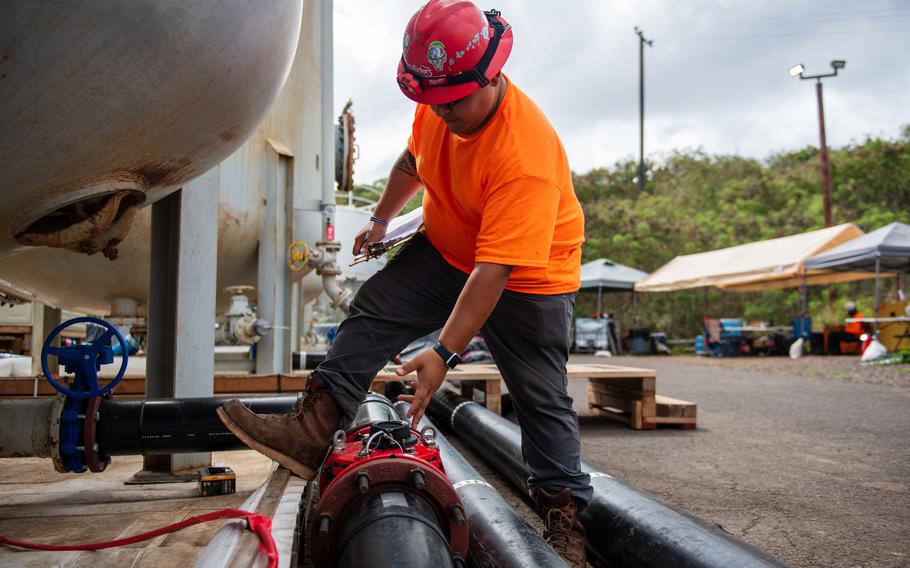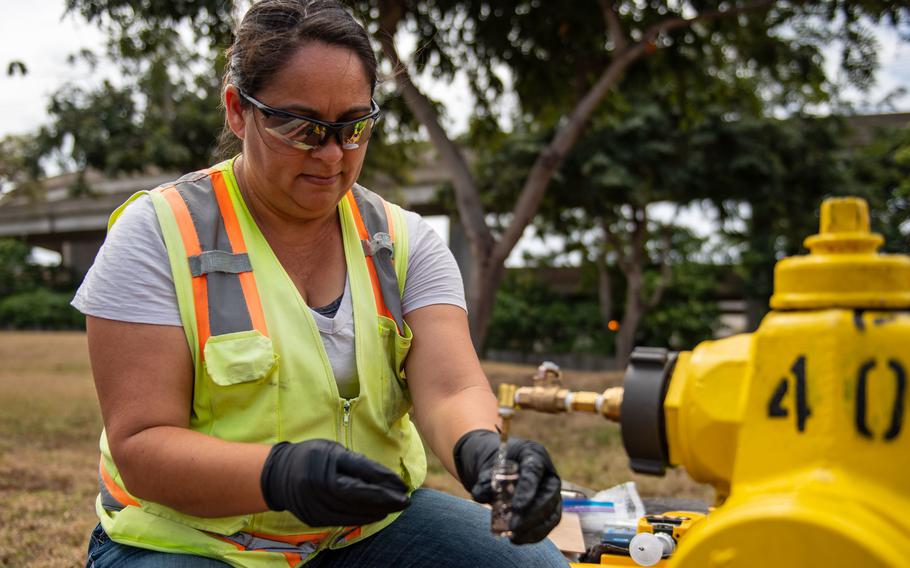
A Navy contractor checks the water flow rate in a carbon-filter system on April 18, 2022, as a part of monitoring at the Navy’s Red Hill well in Hawaii. (Mar’Queon A. D. Tramble/U.S. Navy)
FORT SHAFTER, Hawaii — Another 102 current and former residents of military housing in Hawaii have filed claims seeking compensation for maladies and hardships they say were caused by the Navy’s petroleum-contaminated drinking water, their attorneys said Friday.
The 102 individuals filed claims Friday with the Navy’s Office of the Judge Advocate, a prerequisite for filing any future lawsuits under the Federal Tort Claims Act in federal court, according to a news release by Just Well Law of Austin, Texas, and Hosoda Law Group of Honolulu, the firms representing them.
Fifteen individuals, represented by the same firms, filed such claims in February.
The filings launch a six-month administrative process during which the Navy and law firms will negotiate on compensation for the claims.
Thousands of residents of military housing communities on and near Joint Base Pearl Harbor-Hickam were temporarily displaced to area hotels for several months in the wake of petroleum contamination in the Navy’s water distribution system discovered in late November.
Some residents, as well as pets, were sickened by the foul-smelling tap water, often accompanied by an oily sheen. The Navy traced the contamination to jet fuel that had leached into one of three wells used for its water system.
The source of the fuel is believed to be the Red Hill Bulk Fuel Facility, a vast underground storage facility built during World War II. Two fuel spills occurred last year leading up to the well contamination, one in May and another in November.

A Navy contractor collects a water sample on April 8, 2022, at Catlin Park, a military housing community near Joint Base Pearl Harbor-Hickam, as part of a long-term water monitoring plan. (Mar’Queon A. D. Tramble/U.S. Navy)
On March 7, Defense Secretary Lloyd Austin ordered the facility to be emptied and permanently closed, a process expected to take at least a year.
In a letter to the Office of the Judge Advocate on Friday, the attorneys wrote that the Navy was negligent in its failure to act after the May 6 leak “released thousands of gallons of jet fuel into the Red Hill well.”
“Instead, the Navy allowed families to continue to bathe and drink water until the contamination became so severe — after another spill in November — that it burned their throats and bodies,” the attorneys wrote.
The Navy’s “lack of transparency” has continued to the present, they wrote.
“The Navy refuses to release the test results taken from our clients’ drinking water in November and December 2021 — prior to flushing,” the attorneys wrote. “Although we know the levels of hydrocarbons were high, the Navy chooses to leave these families in the dark as to the extent of their toxic exposure.”
The Navy’s chief of information, Rear Adm. Charlie Brown, said in an emailed statement Friday that the Navy “will not discuss any potential future legal actions.”
In their letter, the attorneys highlighted the cases of several families filing claims.
Amanda and Michael Zawieruszynski, who have three children, began feeling the effects of contamination in November.
“The family experienced symptoms like severe headaches, gastrointestinal problems, sore throat, rash, and more,” the letter said. “Amanda’s symptoms progressively worsened. Within four months, she has now developed nerve damage in her brain, requiring excruciating injections every four weeks.”
Ryan and Tiffany Overbaugh and their two children moved into a home on Ford Island just days before the Nov. 20 fuel spill from the storage tanks, the attorneys wrote.
The family has been “crippled with a myriad of health problems” arising from consuming tap water they had assumed was safe, the attorneys wrote.
“The Navy never notified Tiffany that the water on Ford Island was affected,” they wrote. “She and her family continued to drink the water until Navy officers came to her home in January to flush the system. It was only then that Tiffany realized that officers would not be flushing her home if their water had not been affected.”
An environmental testing firm contracted by the attorneys tested air quality in 20 affected homes between Feb. 21 and April 15.
The testing “has shown that the contaminants have aerosolized and are still present in the air of these homes, the attorneys wrote in the letter.
The May 3 report by Apex Environmental Safety and Health found elevated levels of more than two dozen volatile organic compounds in the samples taken.
Among them were tetrahydrofuran, which when breathed in can irritate the nose, throat and lungs and cause coughing and shortness of breath. High levels of exposure can damage the body’s organs.
“Many of our clients are now suffering from long-term effects, including seizure disorders, thyroid abnormalities, liver damage, kidney damage, baby loss, cognitive challenges, loss of movement, and cancer,” the attorneys wrote.